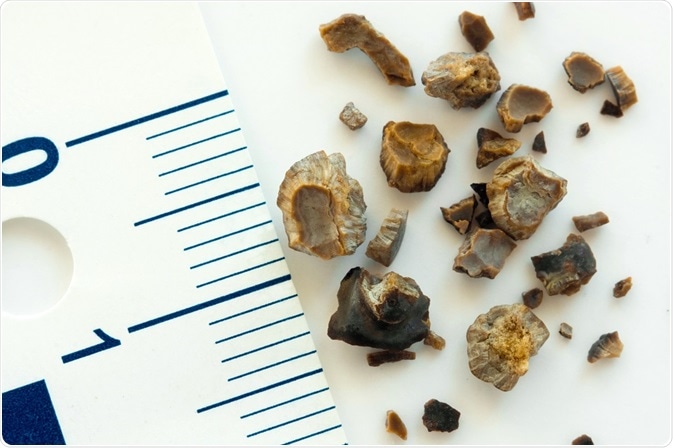Ureteric calculi are stones in the ureters, which are the narrow muscular tubes that are responsible for the drainage of urine from the kidneys to the bladder. These stones are mostly made up of calcium, but some are composed of struvite (i.e. magnesium ammonium phosphate), while a few are made of uric acid, and a minority of cysteine.

Stone size can predict the spontaneous passage of ureteric calculi. Credit: Evan Lorne/ Shutterstock.com
Inadequate fluid intake is the strongest environmental factor associated with stone formation. Also implicated in the etiopathogenesis of ureteric calculi are heredity, diet, anatomical abnormalities of the urinary tract and chronic urinary tract infections (UTIs). Hormonal imbalances and metabolic derangements, as well as hot/ dry climates, are also linked to ureteric calculi.
Patients with stones in the ureters may present with colicky pain that is abrupt in onset and very intense. Depending on the location within the ureters, this pain may radiate to the flank, back and/ or lower abdomen. This may be associated with blood in the urine, nausea and vomiting, among other signs and symptoms.
Diagnosis is made on the basis of an imaging modality, such as kidney-ureter-bladder (KUB) radiography, ultrasonography or computed tomography (CT). This may be further complemented by blood tests, and the analysis of the stone as well as of the patient’s urine. Treatment varies according to the stone size, shape and composition, as well as associated complications. Uncomplicated small stones are treated with increased fluid intake and observation, while more complicated cases may require medication and/ or surgical operations.
Sexual intercourse and the clearance of distal ureteric stones
Some researchers have come to a conclusion that having sexual intercourse may be an effective way to clear stones less than 6 mm in diameter that are present in the distal parts of the ureters. These investigators suggest that distal ureteral smooth muscle relaxation occurs during this act. This relaxation occurs due to the release of nitric oxide during sexual arousal and climax. This in turns assists with the passage of the stone. They recommend having sex three times or more per week.
Investigation into why stone size matters
Jendeberg et al conducted research as to whether it was possible to predict the chances of a stone passing spontaneously with accuracy, based on its width and location within the ureter. For their investigation they employed the use of non-enhanced CT (NECT) to create smaller than ever before predictive models. They concluded that NECT can be used with a high degree of accuracy to predict the spontaneous passage of ureteric calculi, and that size combined with location of the stone are the most important parameters in this prediction. Their research is pivotal in helping clinicians to adopt better approaches to treating patients.
The safer laparoscopic approach to managing proximal ureteric calculi
A group of researchers conducted an investigation into the safety and feasibility of trans- and retroperitoneal laparoscopic approaches for the surgical management of proximal ureteric stones. The goal of this study was to find which method offered more of an advantage for specialists who may have just recently finished a training programming in laparoscopy. These researchers observed that the transperitoneal approach, in contrast to its retroperitoneal counterpart, was better for the less-experienced laparoscopic surgeon. This is because it offers a wider operating field, as well as offering a more familiar anatomical landscape. Moreover, suturing is more convenient with this procedure.
References:
- http://uroweb.org/wp-content/uploads/EAU-Guidelines-Urolithiasis-2015-v2.pdf
- https://www.ncbi.nlm.nih.gov/pubmed/26142575
- https://www.ncbi.nlm.nih.gov/pubmed/28593428
Further Reading
- All Urolithiasis Content
- What is Urolithiasis?
- Causes of Ureteric Calculi
- What is Urolithiasis?
- Ureteric Calculi
Last Updated: Feb 27, 2019

Written by
Dr. Damien Jonas Wilson
Dr. Damien Jonas Wilson is a medical doctor from St. Martin in the Carribean. He was awarded his Medical Degree (MD) from the University of Zagreb Teaching Hospital. His training in general medicine and surgery compliments his degree in biomolecular engineering (BASc.Eng.) from Utrecht, the Netherlands. During this degree, he completed a dissertation in the field of oncology at the Harvard Medical School/ Massachusetts General Hospital. Dr. Wilson currently works in the UK as a medical practitioner.
Source: Read Full Article